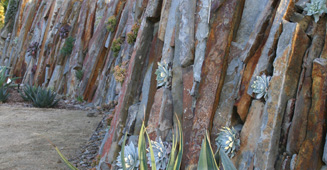

Contributor
- Topics: Archive

Nature Gardens
Natural History Museum of Los Angeles County
At the edge of a quiet stream, a Mourning Dove wades and drinks. A Western Kingbird drops down just inches away to also sip the clear water. Where is this haven of refreshment? Yes, it is in Los Angeles County, but it’s not in the foothills of the Santa Monica Mountains, nor even the wild spots at Griffith Park. It is just outside the oldest museum building in Los Angeles, the Natural History Museum (NHM). Many birds such as these have acclimated themselves to life in a big city. But when the same camera trap that captured these images also reveals a Cooper’s Hawk taking a leisurely bath, an American Crow dunking his daily bread, and both Western Tanagers and Hooded Orioles taking advantage of this refuge, it indicates that something special has been created here.
The NHM is actually a “family” of museums that includes the Natural History Museum in Exposition Park, the Page Museum at the La Brea Tar Pits (showcasing fossils that continue to be discovered in the oozing tar pits), and the William S. Hart Park and Museum (preserving his mansion and ranch as well as exhibits of ranch animals). More than one million visitors enjoy these facilities and exhibits each year. The collections of objects representing the natural and cultural history of the region as well as from around the world are among the most extensive and valuable in any museum.

In 2013, the Museum turned 100 years old, having opened the same year as the Los Angeles Aqueduct. A few years ago, it was clear to the administrators, curators, and facilities managers that it was time for modernization. Major physical renovations to the buildings and infrastructure at NHM began in 2006 and included upgrades to address seismic issues on a scale never before attempted. That work is invisible, but the restoration of the Beaux Arts-style historic landmark also included restoring the sagging stained glass in the rotunda, resealing the dome’s tilework, polishing all the marble and gilt decorations, and replacing dim skylights to allow more light to showcase the improvements. NHM is now not only an iconic piece of Los Angeles history, but a modern museum designed to take its scientists and the public into the next century.

As the improvements were nearing completion, it was time to turn outward and connect the natural world with the museum. This phase included construction of the Nature Gardens, a designed landscape on 3.5 acres, and the Nature Lab, a highly interactive indoor exhibit space. NHM’s research, education, and exhibits staff worked closely with Mia Lehrer + Associates in designing the Nature Gardens. According to Karen Wise, Vice President of Education and Exhibits, “Between our new Nature Gardens and the resources of the Nature Lab, Angelenos can connect the ongoing work of our scientists with the diverse urban wildlife of greater Los Angeles in ways that are directly relevant to all of our daily lives.”

The new landscape consists of several areas for interactive and passive learning. Most of the plants are from mediterranean climate regions, with roughly 60 percent being California natives. Plant selections were based upon habitat value, appropriateness to the climate in the Los Angeles area and, of course, aesthetics. Species and even the hardscape components were chosen to maximize habitat for urban wildlife.

The Transition Garden begins at the street (Exposition Boulevard) and represents the history of plants introduced to Southern California from the time of the Spanish missions to today. There is a Living Wall constructed of natural stone plinths whose joints support a myriad of plant species. The wall also provides places for spiders, insects, and hoped-for lizards, which used to be more widespread throughout the Los Angeles Basin.

Visitors can hear the amplified sounds of water coursing through the roots and xylem of a coast live oak (Quercus agrifolia) at the Listening Tree or stroll on to the Bird Viewing Platform to zero in on the many birds flitting among the woodsy vegetation. Los Angeles is the second “birdiest” county in the United States, and Ornithology Collections Manager Kimball Garrett has identified 172 different species of birds so far. In the Get Dirty Zone, students of all ages can participate in hands-on, soil-oriented activities such as hunting for earthworms and pillbugs in compost, sifting soil, and making adobe bricks. An Edible Garden of fruit trees, berries, herbs, and vegetables showcases the incredible diversity of food plants one can grow in this metropolis. A slate of hands-on edible gardening classes routinely sells out. A somewhat formal Pollinator Garden, with native and exotic plants arranged by flower color, is already in place and has just been joined by a second Pollinator Garden that will also welcome helpful insect and hummingbird pollinators. The newer one is a meadow-like garden composed entirely of California natives. The Amphitheater, a hub for social events such as film screenings and lectures, also serves as a display garden featuring water-thrifty turf alternatives and can be easily viewed from the café patio.

Central to the Nature Gardens, though, is the magical pond and streambed that has proved very attractive to local wildlife. The seasonally dry streambed runs from the pond through riparian woodland before transitioning to oak woodland and coastal scrub vegetation upslope. Museum scientists have already tracked hundreds of mammals, birds, and insects in Exposition Park, but the pond and biofilter in particular have drawn many more creatures to visit and colonize the new habitats. The pond is also very popular with school groups, who participate in ponding activities to see what kind of life is in the water itself.

Taken together, all these exhibit spaces provide habitat for flora and fauna and offer visitors an opportunity to experience nature within a densely urban environment. The gardens also serve as a field site for research programs that engage citizen scientists. Dr. Brian Brown, Curator of Entomology, expects that, “The Nature Gardens will generate important research on the area’s rich biodiversity. It is the world’s first long-term, institutionally sponsored, urban biodiversity survey and monitoring project.” For example, by using iNaturalist, an online community where nature enthusiasts can map and share their observations, visitors can snap photos of animals and plants living in the new Nature Gardens and help museum scientists document how many species of wildlife are visiting or living in the new space. Museum staff also plan to launch pollinator counts for the Great Sunflower Project with the help of visitors and, in the process, teach them how to conduct these counts in their own backyards or school gardens.

From a horticultural perspective, the Nature Gardens provide an opportunity to demonstrate sustainable gardening practices to visitors. The talented horticulture staff use organic fertilizers and generate compost and compost tea from green waste generated on site. They use electric power tools rather than gas-powered equipment and they irrigate the gardens using a computerized system linked to weather satellite data. Integrated pest management is used to control troublesome wildlife, such as Argentine ants, agave root weevils, and the eastern fox squirrel. They realize that the squirrels are here to stay, so bird netting is used to protect young trees from girdling or to ensure that humans can still harvest fruit as it ripens (since the pesky squirrels seem to enjoy them when they are still green).

In creating the Nature Gardens, the museum has taken another major step in fulfilling its mission to inspire wonder, discovery, and responsibility for our natural and cultural worlds. It will be fascinating to watch this young garden grow in the years ahead.
Share:
Social Media
Garden Futurist Podcast
Most Popular
Videos
Topics
Related Posts

Ground Up Science for Greener Cities with Garden Futurist Dr. Alessandro Ossola
Spring 2023 Listen to the Podcast here. Alessandro Ossola is a scientist who gets very excited about the challenge of climate change allowing for an

Readying Urban Forests for Climate Realities with Garden Futurist Dr. Greg McPherson
Winter 2023 Listen to the Podcast here. “Going from the mow and blow to a more horticulturally knowledgeable approach to maintaining the landscape. And that

Low Maintenance Gardens – Better for Pollinators and People
Autumn 2022 “I come out every day. It’s therapy, my meditation.” Janet’s young garden transformed from overgrown, invasive plants to mostly natives. The dailiness of

Invasive Plants Are Still Being Sold: Preventing Noxious Weeds in Your Landscape
Autumn 2022 With so many beautiful ornamental plant species and cultivars throughout California and the Pacific Northwest, how do you decide which ones to include










Responses